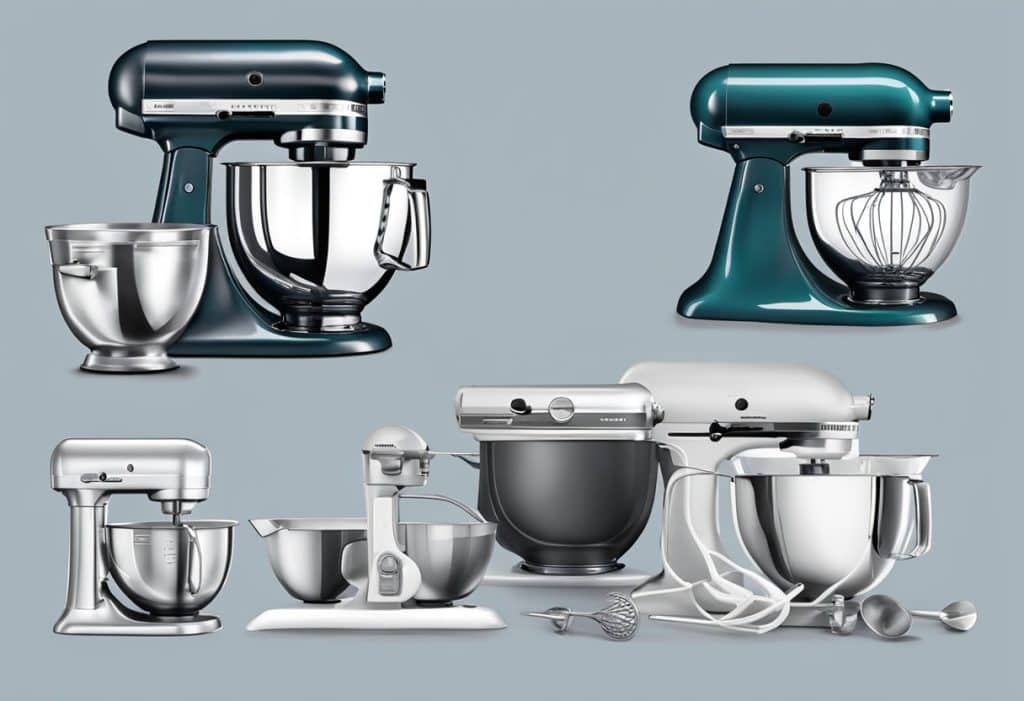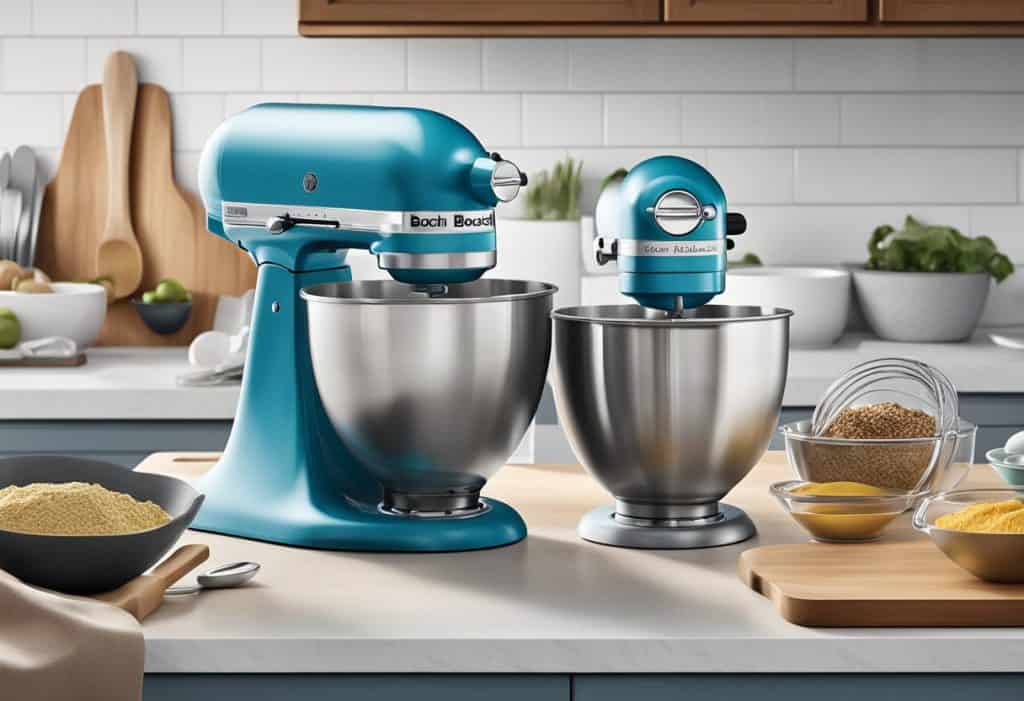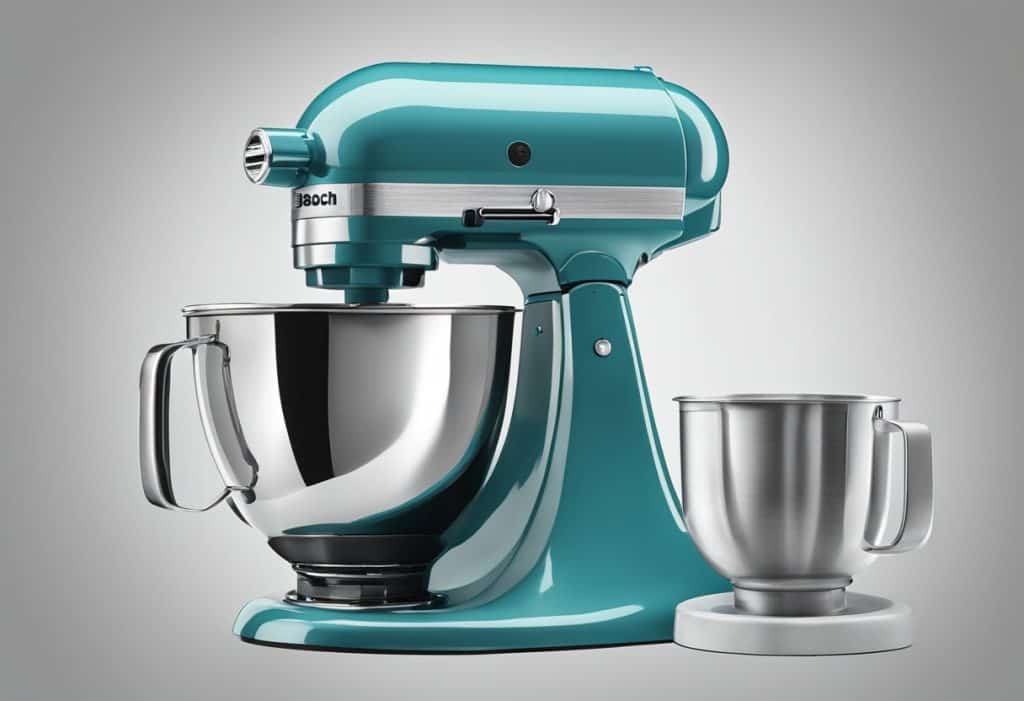When it comes to stand mixers, Bosch boasts a robust 800-watt motor, making it ideal for heavy doughs, while KitchenAid offers versatility with various attachments and a wide range of color options. Both cater to different baking personalities and requirements, so the choice boils down to your unique baking routine
Comparing Bosch and KitchenAid Mixers: Features and Functions
When you’re trying to decide between Bosch and KitchenAid mixers, it’s helpful to look at their features side by side. Let’s break it down for you.
Motor Power:
- Bosch: You’ll find a robust 800-Watt motor in Bosch mixers, giving you ample power for tough doughs.
- KitchenAid: Power can vary by model, typically ranging from 250 to 970 watts.
Mixing Efficiency:
- Bosch: Bosch mixers boast efficient mixing action that assigns heavy-duty tasks to the dough hook and lighter gigs to wire whips.
- KitchenAid: KitchenAid mixers come with a planetary mixing action, where the attachment orbits and the bowl spins.
Attachments and Accessories:
- Bosch:
- Dough Hook: Designed for kneading, it handles bread dough like a pro.
- Wire Whips: From whipping cream to beating egg whites, these get the job done.
- Cookie Paddles: Attach these for mixing cookie dough or other dense mixes.
- KitchenAid:
- Dough Hook: These come in either C-shaped or spiral forms for kneading.
- Wire Whips: Suitable for meringues and whipped cream.
- Cookie Paddles: Available for some models, often as a separate purchase.
Bowl Type:
- Bosch: Comes with a stainless steel bowl, known for its durability.
- KitchenAid: Offers stainless steel as well, with some models featuring a glass or non-stick bowl option.
Your choice will hinge on your baking and cooking needs, whether you knead large batches of bread or whip up occasional meringues. Bosch’s muscle is in its motor, while KitchenAid’s pride is its versatility with various attachments.
Essential Attachments: Bosch vs KitchenAid
When you dive into your culinary experiments, the attachments coming with your stand mixer can make or break the experience. Let’s compare the essential attachments you get with Bosch and KitchenAid mixers.
Bosch mixers usually come equipped with a stirring whisk, beating whisk, and kneading hook. Key optional attachments include:
- Slicer: Effortlessly chops vegetables into consistent sizes.
- Spiralizer: Creates veggie noodles for a healthy twist on pasta.
- Pasta Maker: Allows you to craft homemade pasta with ease.
- Bowl Scraper: Ensures ingredients are well-incorporated without manual scraping.
Bosch also offers unique additions like the Splash Ring to keep ingredients contained and a Plastic Whip Driver for airy batters.
KitchenAid mixers start you off with a flat beater, wire whip, and dough hook. For KitchenAid, additional attachments you can snag are substantial:
- Slicer/S edder: Quickly prepares veggies for salads, stir-fries, or toppings.
- Spiralizer: Turns fruits and veggies into spirals and sheets.
- Pasta Maker: Expands your pasta-making repertoire significantly.
- Sifter + Scale: Ensures precise measurements for flawless baking results.
Storage-wise, KitchenAid shines with its attachment hub and stowaway solutions. You’ll find a place for your attachments without cluttering your kitchen. Bosch, on the other hand, may require separate storage solutions for your attachments.
When choosing between Bosch and KitchenAid, think about your specific needs and the kinds of dishes you want to create. Both offer a solid range of attachments, but they have their own strengths, and picking the right one for you will elevate your kitchen game.
Lifespan and Durability: Bosch and KitchenAid Mixers

When you’re mixing up big batches or tackling tough dough, you want a mixer that’s going to last. That’s where assessing the lifespan and durability of Bosch and KitchenAid mixers becomes crucial for your decision.
Bosch Mixers are renowned for their robust build and long lifespan. They’re designed to handle heavy batch sizes, translating to a sturdy partner in the kitchen for years. You can expect a Bosch mixer to stick around, often withstanding significant workloads without a hitch.
On the flip side, KitchenAid Mixers are equally praised for their longevity. They stand out as an investment item with a heftier price tag, but they deliver on durability. The all-metal construction affirms their ability to withstand frequent use, especially the professional models which are built to handle heavier workloads.
Here’s a quick breakdown:
| Aspect | Bosch | KitchenAid |
|---|---|---|
| Lifespan | Long, years of reliable use | Long, solid investment |
| Durability | High, can tackle heavy loads | High, all-metal construction |
| Heavy-Duty Use | Well-suited for large batches | Good for frequent, heavy use |
| Suction Cups | Sturdy suction for stability | Typically uses non-slip base |
| Investment Item | Good value over time | Higher initial cost, but durable |
Remember, your mixer’s lifespan also greatly depends on how well you maintain it. Regular cleaning and proper use can help any mixer outlive expectations. Whether you lean towards Bosch for its powerful efficiency or KitchenAid for its impeccable reputation, you’re in for a durable kitchen companion.
Price Point Analysis: Bosch vs KitchenAid

When eyeing mixers for your kitchen, you’ll notice Bosch and KitchenAid stand out, but there’s a noticeable price difference that might catch your attention.
Bosch mixers tend to fall on the pricier side, especially when compared to smaller KitchenAid models. Your purchase decision can hinge heavily on what you’re willing to spend.
Now, if you’ve been searching for the creme de la creme of mixers, you may have stumbled upon the KitchenAid 6-Quart Professional Series Stand Mixer, often hailed for its robust power and versatility. Let’s crunch some numbers:
| Mixer Model | Price Range |
|---|---|
| Bosch Universal Plus Mixer | $$$$ |
| KitchenAid Artisan Series | $$$ |
| KitchenAid 6-Quart Pro Series | $$$$ |
The Bosch Universal Plus stands at the higher end of the market, matching closely with our favorite—the KitchenAid 6-Quart Pro. However, the Artisan Series from KitchenAid can be a more budget-friendly option if you’re not looking to splurge or require all the bells and whistles of the Pro model.
In the mixer market competition, you’re paying for quality, durability, and the features each brand brings to your kitchen. Bosch’s sticker price reflects a long-standing reputation for high-performance kitchen appliances. In contrast, KitchenAid provides a range of prices and models to suit different needs and wallets.
Remember, the initial cost is just one part of your investment; consider what you’re getting for the price, like warranty, capacity, and accessories. Your final pick should give you the best mix of features and affordability for your baking and cooking adventures.
Pros and Cons: Bosch and KitchenAid Stand Mixers

When comparing Bosch and KitchenAid stand mixers, you’ll want to look closely at what each offers.
Bosch:
Pros:
- Power: Your Bosch Universal Plus 6.5 Quart Mixer has a robust 800-watt motor, ideal for heavy doughs.
- Capacity: Great for large batches without sacrificing quality.
- Weight: A bit lighter, easier to move around.
Cons:
- Design: Not as many color options as KitchenAid.
KitchenAid:
Pros:
- Design: The Artisan 5 Quart Tilt-Head Stand Mixer comes in various colors to match your kitchen.
- Tilt-Head: Offers easy access to the bowl.
- Warranty: Comes with a 1-year warranty as standard.
Cons:
- Power: Sports a lower power output in comparison to Bosch, with the Artisan typically at 325 watts.
- Weight: Slightly heavier, which could impact portability.
Here’s a quick glance to compare:
| Feature | Bosch Universal Plus 6.5 Qt | KitchenAid Artisan 5 Qt |
|---|---|---|
| Motor Power | 800 watts | 325 watts |
| Mixer Type | Bowl Lift | Tilt-Head |
| Weight | Lighter | Heavier |
| Capacity | Larger batches | Medium batches |
| Color Options | Limited | Extensive |
| Warranty | Varies by retailer | 1-year standard |
Remember, the right mixer for you depends on your baking needs and preferences. Bosch shines with power and is versatile for both hefty and small tasks. KitchenAid stands tall on style and is a longstanding favorite for many home bakers.
Unique Features: Color Options and Design Differences

When you’re eyeing that countertop upgrade, color options can be a real kicker. Bosch’s Universal Plus mixer, for instance, sticks to a more classic look, primarily in white. This gives your kitchen that timeless vibe.
On the flip side, KitchenAid’s lineup, like a painter’s palette, offers a color variety that’s tough to beat. You can match it with your kitchen’s personality, whether that’s a sleek Onyx Black or a pop of Majestic Yellow.
Speaking of customization, KitchenAid has a leg up if you’re into custom builds. With their color variety, you can personalize your machine to your heart’s content, while Bosch’s options are more on the minimalist side. So, if expressing your unique style is your jam, KitchenAid might be your go-to.
Now, let’s talk size. The Bosch Universal Plus mixer boasts a compact machine footprint, allowing you to save precious counter space. Its design is pragmatic, efficient, without too many frills. KitchenAid mixers, while offering a user-friendly design, tend to take up a bit more room. So, if your space is at a premium, size matters.
Both brands have designed their mixers with your user experience in mind. Bosch touts ease with a simple setup, whereas KitchenAid mixers feature a tilt-head or bowl-lift design, letting you choose based on how you prefer to mix things up. It’s all about what feels right for you, and your kitchen.
Making the Right Choice: Which Mixer Suits Your Baking Style?

When picking out the perfect mixer for your baking ventures, your style and needs are key. Bosch and KitchenAid mixers cater to different baking personalities and requirements. Let’s break it down:
Baking Needs:
- If you’re into whipping up multiple batches at once, a Bosch mixer with its high capacity might be your new best friend.
- For those of you who find joy in the occasional cake or cookies, a KitchenAid offers versatility without overwhelming your space.
Countertop Space:
- Got a cozy kitchen? A KitchenAid mixer’s sleeker design is often more compact.
- If you’re not worried about space and want a workhorse, a Bosch with its larger footprint has the muscle.
Baking Styles:
- Artisan bread aficionados may lean towards the Bosch for its robust dough handling.
- More casual bakers who like to experiment with different recipes might appreciate the attachment variety of a KitchenAid.
Flour Overuse:
- No need to waste flour. KitchenAid’s clear bowl lets you check your dough’s consistency, potentially cutting down on flour use.
- Bosch tackles heavy loads with ease; however, keeping an eye on the right flour consistency may require a bit more judgment.
Batch Handling:
- Big family? The Bosch mixer’s greater capacity is a plus for handling larger batches with ease.
- Smaller gatherings? KitchenAid will manage the quantities just right, avoiding over or undermixing.
Appliance Options:
- KitchenAid is known for its array of colors and finishes—great if you’re keen on matching with your kitchen’s vibe.
- Bosch tends to focus on functionality and doesn’t offer the same color range, but its mixers are no less efficient.
Your choice boils down to your unique baking routine—match the mixer to the baker, and you’re set for success!


